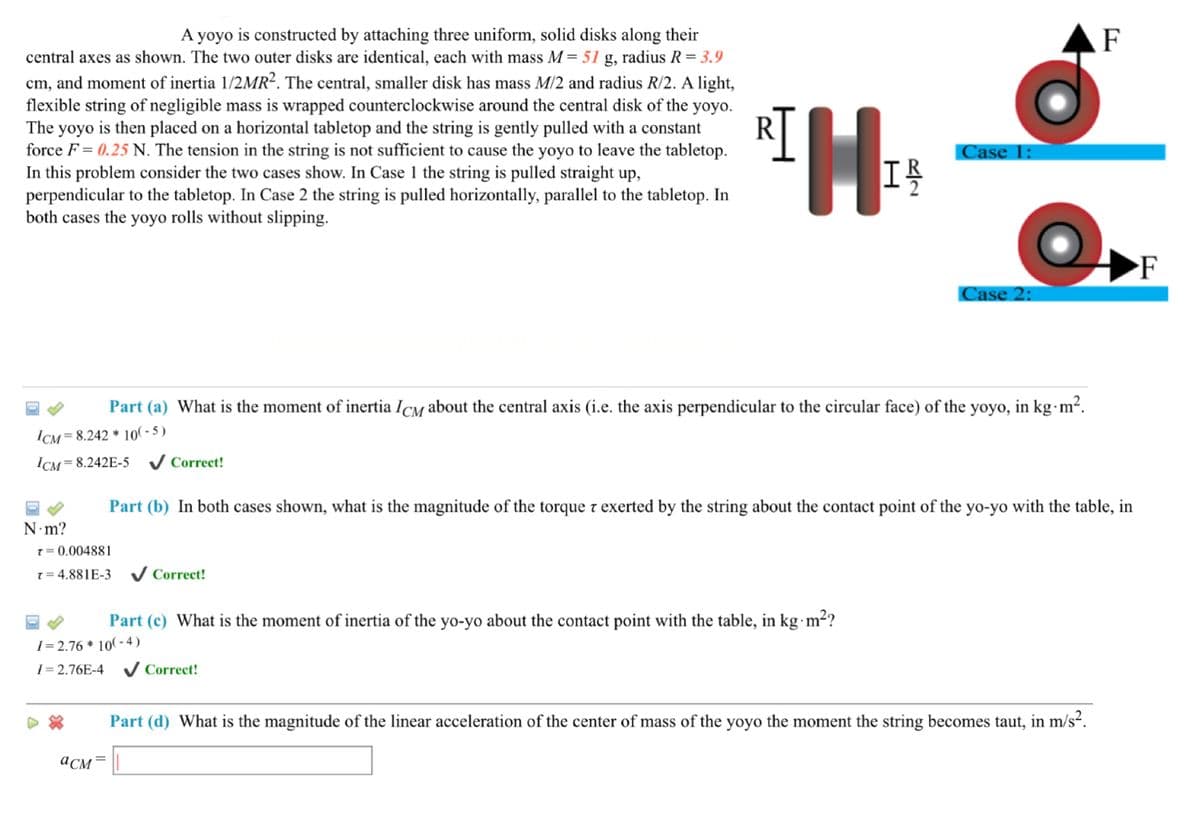AF A yoyo is constructed by attaching three uniform, solid disks along their central axes as shown. The two outer disks are identical, each with mass M= 51 g, radius R= 3.9 cm, and moment of inertia 1/2MR². The central, smaller disk has mass M/2 and radius R/2. A light, flexible string of negligible mass is wrapped counterclockwise around the central disk of the yoyo. The yoyo is then placed on a horizontal tabletop and the string is gently pulled with a constant force F = 0.25 N. The tension in the string is not sufficient to cause the yoyo to leave the tabletop. In this problem consider the two cases show. In Case I the string is pulled straight up, perpendicular to the tabletop. In Case 2 the string is pulled horizontally, parallel to the tabletop. In both cases the yoyo rolls without slipping. Case 1: Case 2: Part (a) What is the moment of inertia ICM about the central axis (i.e. the axis perpendicular to the circular face) of the yoyo, in kg m2. ICM-8.242 10-5) ICM - 8.242E-5 V Correct! Part (b) In both cases shown, what is the magnitude of the torque z exerted by the string about the contact point of the yo-yo with the table, in N m? r-0,004881 =4.88IE-3 V Correct! Part (c) What is the moment of inertia of the yo-yo about the contact point with the table, in kg m2? 1= 2.76 * 10( - 4) |= 2.76E-4 V Correct! Part (d) What is the magnitude of the linear acceleration of the center of mass of the yoyo the moment the string becomes taut, in m/s. асм-
Angular Momentum
The momentum of an object is given by multiplying its mass and velocity. Momentum is a property of any object that moves with mass. The only difference between angular momentum and linear momentum is that angular momentum deals with moving or spinning objects. A moving particle's linear momentum can be thought of as a measure of its linear motion. The force is proportional to the rate of change of linear momentum. Angular momentum is always directly proportional to mass. In rotational motion, the concept of angular momentum is often used. Since it is a conserved quantity—the total angular momentum of a closed system remains constant—it is a significant quantity in physics. To understand the concept of angular momentum first we need to understand a rigid body and its movement, a position vector that is used to specify the position of particles in space. A rigid body possesses motion it may be linear or rotational. Rotational motion plays important role in angular momentum.
Moment of a Force
The idea of moments is an important concept in physics. It arises from the fact that distance often plays an important part in the interaction of, or in determining the impact of forces on bodies. Moments are often described by their order [first, second, or higher order] based on the power to which the distance has to be raised to understand the phenomenon. Of particular note are the second-order moment of mass (Moment of Inertia) and moments of force.

Trending now
This is a popular solution!
Step by step
Solved in 5 steps with 8 images









